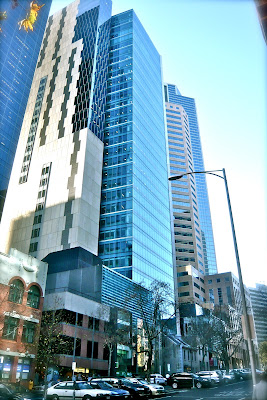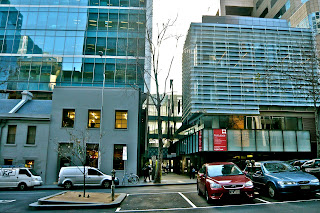 |
| Lonsdale Street, 2010 (my own photo) |
Walking past these days, you would be forgiven for thinking that the city block bordered by Lonsdale, Little Lonsdale, Exhibition and Spring Streets is just like any other. Glass skyscrapers and concrete office blocks overlook a handful of nondescript shops and cafes catering to city workers. It all seems pretty ordinary. So ordinary, in fact, that you might never know that this was once Little Lon: a so-called "den of iniquity," a slum filled with brothels, opium dens and, yet, as recent evidence has shown, a vibrant community and network of laneways.
 |
| Lonsdale Street, 2010 (my own photo) |
Little Lon first emerged as a working-class, residential precinct in the 1840s and 50s. Initially, it attracted impoverished immigrants, mainly from Ireland, who were unable to afford housing in the more reputable parts of the city. By 1900, it was one of the most culturally diverse areas in Melbourne, with Chinese, Italian, Syrian and Jewish residents all living cheek-by-jowl in rows of small cottages. Little Lon was filled with cottage industries started up by its residents, such as cabinet making, clothing manufacturing and printing. Despite its sordid reputation for crime and debauchery, it seems that Little Lon was also home to a dynamic and resourceful community of diverse people.
 |
| Cumberland Place in Little Lon, 1901 (Museum Victoria) |
This is not to say that a seedier side did not exist. Little Lon was a notorious red-light district, with eight of its brothels in the nineteenth century owned by the delightfully spirited Madame Brussels! Poet C.J Dennis wrote about the slums and opium dens of Little Lon in The Songs of a Sentimental Bloke (1915) and the Truth newspaper called it "the street of evil." In 1948, the Commonwealth Government compulsorily acquired most of Little Lon, after facing pressure to clean up the area and abolish the slums. The next few decades saw the levelling and redevelopment of the site, including construction of the Commonwealth Centre ('Green Latrine' - now also demolished), Telstra's national headquarters, government office blocks and upmarket residential enclaves.
 |
| Melbourne Opium Den, 1896 (State Library of Victoria) |
At the time, better housing for the poor was urgently needed. However, it is now interesting to consider how the demolition of Little Lon led to a major part of Melbourne's history and character vanishing forever. The large office blocks subsumed laneways that were once inextricably connected to the lives and work of the inhabitants of Little Lon. The following two images show a 'before and after' aerial view of the block, firstly in 1925 and then in 2010.
 |
| Google aerial view of the same area, 2010, showing the Telstra National Headquarters, Department of Human Services and other office blocks. |
As Melburnians, we delight in the fact that our city is made up of unique laneways - in which some of our best restaurants, bars and boutiques are hidden (click here to watch Streetfilm's video about this topic.) And yet, for those of us too young to remember, we seldom consider the vast network of lanes that have been subsumed by large, modern redevelopments of entire city blocks, including Little Lon, the Rialto Tower, Melbourne Central shopping centre, and the list goes on. Losing these lanes inevitably involves losing a sense of Melbourne's past. When the laneways vanish, our connection with (and understanding of) past communities is at risk of vanishing too.
 |
| Birthday party in Casselden Place, Little Lon, 1914 (Museum Victoria) |
In my next post, I will look at some of the interesting ways that we can try to gain an insight into the vanished community and laneways of Little Lon. I will visit the Urban Workshop at 50 Lonsdale Street, the one remaining home in Casselden Place and view the fascinating objects discovered during archaeological digs of the site. If you have an idea or any information about Little Lon, please email me!
References:
Bate, Weston, Essential But Unplanned: The Story of Melbourne's Lanes (1994)
Hider, Annie, Growing up in the City (interview with Marie Hayes): http://museumvictoria.com.au/littlelons/grow.html
Leckey, John, Low, Degraded Broots? Industry and Entrepreneurialism in Melbourne's Little Lon, 1860-1940 (2004)
www.emelbourne.com.au
www.museumvictoria.com.au

3 comments:
I find the website that you have created earlier has very insightful information, and I discover it very informational.
I really liked this post. You explain this topic very well.
Very interesting and informative post.
Thanks for sharing it.
My grandmother lived at 9 Casseleden Place in 1914. I love this site. Do you have more information or photos.
This is great.
My grandmother lived at 9 Casseleden Place in 1914, do you have more info or photos?
Post a Comment